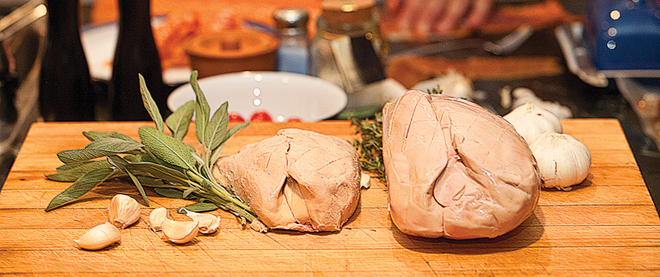Foie gras: Duck, duck, and finally some goose
Prized for its richness, a delicacy from Hungary makes an appearance in Canada
Photographs by Colin O’Connor
Share

There is a small community of Canadian gourmands who worry that duck foie gras is simply not rich enough, and that something better exists elsewhere that is unavailable here. We have no support group but each other. And this close-knit relationship explains why rumours spread so quickly this spring that a Quebec distributor was importing fresh whole lobes of foie gras from Hungary—not small ones, sourced from elegant, svelte little ducks, but the Brobdingnagian stuff, plucked from fat, lumbering geese.
Finally, one happy afternoon a few weeks ago, a cab rolled up to my front door with nothing in the passenger seat but a plump, yellow, one-kilogram goose liver, sporting a label from an importer in Laval, Que., called Cunico (about $55 a pound, if your butcher can get it for you). The foie gras was a gift from my friend Arpi Magyar, a wonderful and passionate chef who, in 2003, after 20 years in charge of some of the better restaurant kitchens in Toronto, turned his hand to catering and opened Couture Cuisine.
Magyar grew up in Hungary, which is the second-largest producer of foie gras in Europe after France, and its largest exporter (primarily to insatiable France). And unlike France, where most foie gras comes from moulard ducks, Hungarian foie gras is almost always sourced from geese.
Geese evidently like it there. Whether they are French and grey-feathered or Hungarian with white plumage, they especially enjoy the sunny, temperate climate and sandy soil of Hungary’s southern plains. In France, geese are most at home in Périgord and Alsace (the birthplace of pâté de foie gras d’oie, and the only French region where geese vastly outnumber ducks). But they cannot abide the North American climate, which is why all the great producers in New York state and Quebec focus on ducks, and fresh goose foie gras has always been so hard to find.
In Hungary, meanwhile, it is so cheap and commonplace as to be considered more a staple than a delicacy. Magyar once told me that in the old country he used to eat seared foie gras and bacon sandwiches for breakfast. “Usually we just braise it in goose fat, and then to serve it, pour it into a jar with a little extra fat on top. You eat when it’s still warm—so it’s very easy to spread,” he explained, while I checked the price of flights to Budapest on my BlackBerry.
Most but not all foie gras enthusiasts prefer goose to duck. There is a consensus that goose yields a richer liver, which delivers a more smoothly textured terrine and a superior seared escalope, because the larger size allows for better-shaped slices and because the properties of its tissue mean that it surrenders less of its fat in the hot pan. Its flavour is also less assertive than that of duck liver, which probably helps the impression of greater richness, as your taste buds are left to focus, undistracted, on texture and fattiness.
Such is the theory, anyway. But as I see it, all theories are to be tested, so I procured a nice duck foie gras from Quebec (about $70 a pound) for comparison, invited a few friends over and got to work. I wanted to roast it whole, an extremely decadent approach to an admittedly decadent snack, which Mark McEwan demonstrated for me some years back at my family’s cottage in Quebec (he poached the recipe from the great Austrian Eckart Witzigmann, one of four people to be named a chef of the century by the French restaurant guide Gault Millau). In short, you sear the top, rendering the crest of the lobes golden, and then transfer the whole pan to finish in the oven. Braised apples make a perfect accompaniment—along with crostini, a necessary vehicle for transferring the quivering hunks of liver from plate to mouth.
The sauternes flowed and the foie gras was good. To wrap up, the guests were asked which type of foie gras they would pack for a solitary sojourn to a desert island, if they were allowed to bring only one. There was no consensus. While the milder flavour of the goose liver had its fans, its texture was a little mushy. Magyar told me later it was likely an inferior batch. Which means—alas—we will soon have to do it all over again.